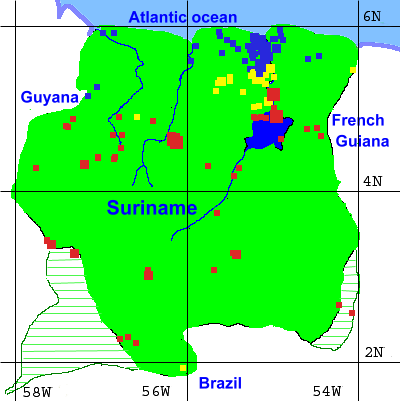| Verspreiding |

Elk klein vierkant stelt minstens één waargenomen vogel voor of een groep, grotere vierkanten minstens vier verschillende dagen met waarnemingen en de grootste vierkanten minstens tien. De kleur geeft aan: blauw voor de kustvlakte, geel voor savanne en rood voor het oerwoud.
Niet alle plaatsen in Suriname worden even goed bezocht door vogelaars, dus de verdeling van de vierkanten geeft een indicatie van de plaats van de vogels, maar ook van de vogelaars. Op sommige plaatsen in het zuiden zijn geen observaties van vogels, door ervaren vogelaars, binnen een straal van 60 kilometer.
|
|
| Voorkomen in diverse zones |
| kustvlakte (blauwe stippen op de kaart) : |
 |
| noordelijke savanna (gele stippen (in het noorden)) : |
 |
| regenwoud onder 400 m (rode stippen) : |
 |
| regenwoud boven 400 m (rode stippen) : |
 |
| Sipaliwini savanna (gele stippen (in het zuiden)) : |
 |
Blanco als de vogel niet overtuigend is aangetoond in die zone.
Data geïnterpreteeerd door Arie Spaans, Otte Ottema en Jan Hein Ribot.
|
| Namen |
| Wetenschappelijke naam: |
Tangara mexicana |
| Orde: |
Passeriformes |
| Familie: |
Thraupidae, 56 in Suriname |
| Nederlands: |
Turkooistangare, Anijsvink |
| Engels: |
Turquoise Tanager |
| Sranan ('Surinaams'): |
Blauwvink, Anijsvink |
| Guyana: |
|
| Papiamento: |
|
| Spaans (Venezuela): |
Tangara turquesa |
| Portugees (Brazilië): |
Cambada-de-chaves, Coleiro-de-bando |
| Arowaks: |
Sakwie |
| Carib: |
Sakwie, Sjietoelie |
| Frans: |
Tangara turquoise, Calliste diable-enrhumé |
|
 Turquoise Tanager (Tangara mexicana)
Turquoise Tanager (Tangara mexicana)
 Turquoise Tanager (Tangara mexicana)
Turquoise Tanager (Tangara mexicana)